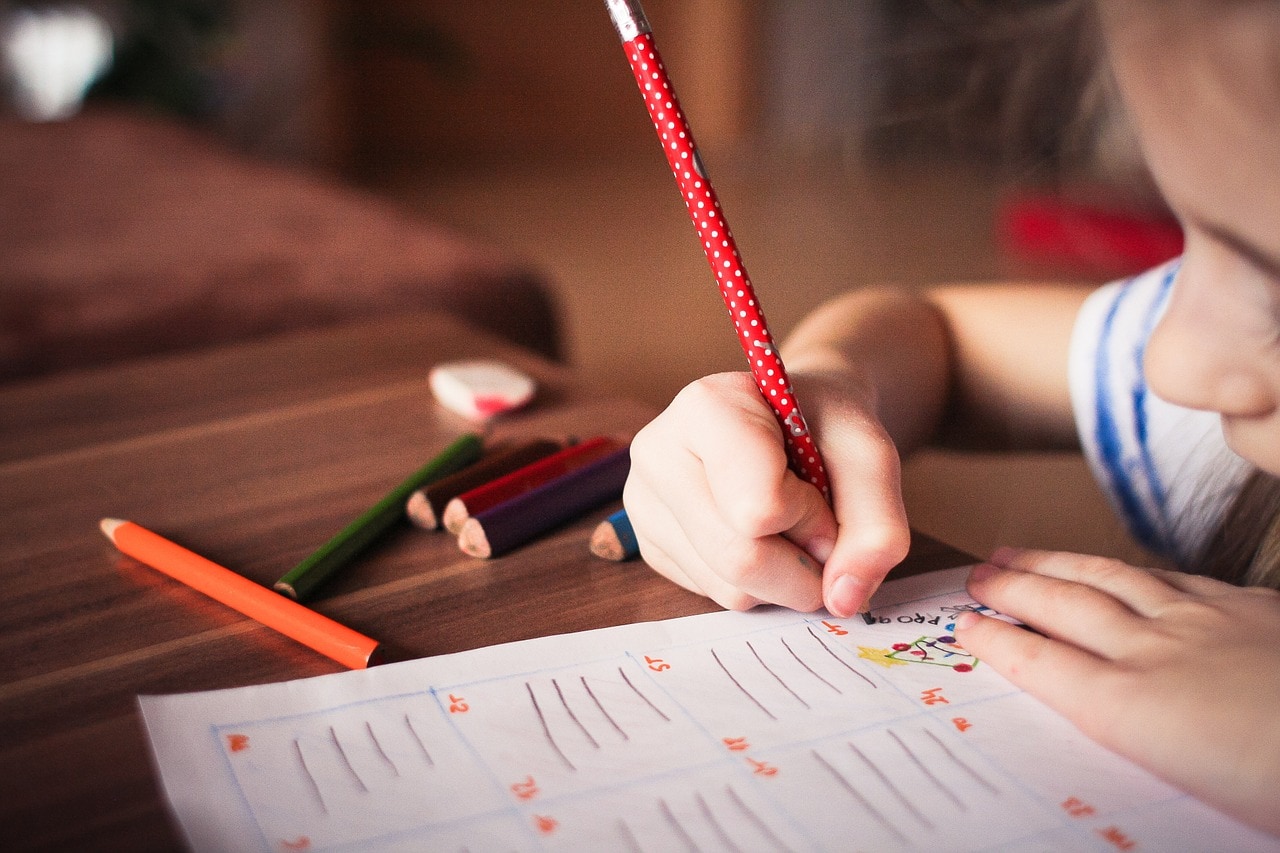Get creative and find new ways to help your kids keep the fun in learning.
Today’s world is full of technology for your little ones to master any subject their heart desires, but nothing beats a face-to-face learning environment. Find ways to make learning fun for your kids offline, free of screens and distractions.
“When you’re playing a learning game, it has to be fun. And wouldn’t it be great if it wasn’t pointless fun?” said Russell Ginns, an educational gaming expert and the producer and director of “The Big Reading Show” app from Hooked on Phonics. “When you create an activity, there’s little difference in gameplay between a game where you match up candy and a game where you match up letters.”
Teaching young children math skills lends itself well to making up games, because the kinds of things kids are learning about make great game pieces, Ginns pointed out. Numbers, letters, shapes, colors, sight words, counting, and math can all be reinforced through recognition, repetition and manipulation.
Later in education, concepts get more sophisticated and abstract, and they don’t lend themselves as easily to games.
“When you sing songs in kindergarten, you’re learning about colors, shapes, numbers and dinosaurs,” Ginns explained. “In contrast, nobody sings a song about trigonometry because that’s not how you learn it.”
Learning games are great for kids because the fun is in challenging themselves.
“For the most part, in the end, kids don’t really care who wins,” said Dr. Peter Gray, a research professor in the Department of Psychology at Boston College and the author of “Free to Learn.” “As a kid, you’re constantly challenging yourself and your play partners, pushing yourself to improve. That’s a natural part of fun that occurs in all sorts of play.”
As a parent or tutor, you know the most expensive games aren’t necessarily the best. All you really need to play some great math games for kids is a pair of dice, some playing cards, or just your imagination. Here’s our list of some of the most inventive games to help your child learn math while having tons of fun.
Games to Help Kids Recognize Numbers
Identifying numbers is a learning experience for kindergarteners, preschoolers, or advanced learners even younger than that. There are endless things to count, but sometimes it can be difficult for young children to understand that numbers mean the same thing no matter what is being counted. That’s where number recognition comes in.
Check out these games to help even the youngest of students become proficient in recognizing numbers on sight.
1. “Sand Sensory Art”
Good for: Preschool & younger
Draw numbers (or have the child draw the numbers if he’s able) and then have the child trace over those numbers with glue. Once the glue is covering all the numbers, the child can then sprinkle sand over them. This creates a sensory game, as well as number recognition for preschool and younger.
2. “Coloring Train Race”
Good for: Preschool
Use the printable on this page to print trains with various shapes. Label each shape with a number. On the players turn, they draw a card and read the number on the card aloud. Then, they find the number on their train and color it. If the player has already colored that number, the other player may color it on their train if that space is still open. Whichever player colors the entire train first, wins!
3. “Math Dominoes”
Good for: Kindergarten
Write numbers from 1 to 10 on the left half of a set of note cards. On the right halves, add 1 to 10 dots. Distribute the flashcards evenly among players. Take turns laying out one flashcard at a time like dominoes, matching the written numerals to the number of dots.
Dice Games to Help Build Math Skills
Anna Geiger, who taught elementary school for eight years before starting her educational blog The Measured Mom, said dice games “help kids learn a variety of math skills. For preschoolers, number recognition, counting and subitizing — looking at the dots on the dice and knowing what number they represent, instead of counting them — are important skills that dice games can teach. Older children can learn adding, multiplying and more by playing more advanced games.”
These four super-fun dice games will help kids from preschool through elementary school.
1. “Dollars and Dice”
Good for: Kids learning addition
Geddis uses Dollars and Dice to help kids work on their adding skills and learn about the value of coins. For this game, you’ll need two dice and some coins — pennies, nickels, dimes and quarters. Start with the coins in the center. Players take turns rolling the dice and taking the smallest number of coins that add up to their roll. For example, if Player 1 rolls a five and a six, she should take a dime and a penny. With each turn, players should trade coins for ones of larger value (if a player has two dimes and a nickel, she should trade them for a quarter). The player who reaches $1.00 first wins!
2. “Checkerboard Dice”
Good for: Preschool
For your preschool mathematician, grab a checkerboard or draw 30 large squares on paper. You’ll need some of your kiddo’s favorite cereal (you can also use crackers or pretzels). Your child rolls one die, and then transfers that number of pieces of cereal to the checkerboard. If she rolls a 3, she puts three pieces of cereal into three separate boxes, which develops counting and subitizing skills. Once the board is full, she eats the cereal and starts again! For an extra challenge, when she gets close to filling in the board, she can only complete it with an exact roll.
3. “Dice War”
Good for: Preschool & kindergarten
This is a great two-player game for younger math geniuses! It helps with number recognition and counting. Start with a pile of dice — at least 10 — in the middle. Each player takes one die, and the players roll together. Whoever rolls the higher number takes both dice. In the case of a tie, each player rolls another die, and the winner takes all four dice. The game ends when all dice are taken from the center, and whoever has more dice wins! You can find this game, more dice math games and other educational tools from Geiger at The Measured Mom.
4. “Add-It”
Good for: Learning basic addition & beyond
Each player starts with two dice and takes turns rolling. Write down the sum of each roll — for example, if Player 1 rolls a two and a five on her first turn, write “seven” on the first line. Add up the results of each turn as you play — if Player 1 rolls a four and a five on her second turn, write “nine” on the second line, and then add the two sums together and write “16” to the right of the dice sum. Keep adding sums from each turn, practicing both one- and two-digit addition skills, until someone reaches 50 to win! For advanced players, you can use a larger winning number. For a twist, you can play Multiply-It, where players multiply the dice — if Player 1 rolls a two and a five on her first turn, you’ll write “10” on the first line. Then you add the results of each of the turns, until someone reaches 100. This helps kids learn basic multiplication and keeps their adding skills sharp.
Games to Help Kids Learn Fractions
Learning fractions can be tough, and it’s hard to watch your kids struggle through their homework. Instead of working through a long lists of math problems, fraction games for kids offer unexpected and fun ways to learn this essential skill. If your kids are having so much fun that they don’t realize how much they’re learning, rest assured you’ve achieved your goal.
Suzanne Sutton, an education consultant and creator of the math site Newton’s Window, believes fractions are an extremely important foundation skill for students.
“Parents may feel that fractions are an ‘early math’ topic, and with the easy access to calculators, they don’t matter much anymore,” Sutton said. “But to be honest, I’ve worked with thousands of students in higher math subjects like algebra, trigonometry and calculus, and the thing that got them hung up and hating those courses was not the harder concepts in the subjects themselves, but their weakness with fractions and other early topics.”
To encourage learning, parents should use simple but fun fraction games for kids.
Fraction concepts may be difficult, but according to Sutton, “Parents shouldn’t convey any messages that fractions are useless, stupid or outdated.”
By working on math concepts together, Sutton said she believes that “parents can turn the tables, have your child explain it to you, let them see you struggle with it. This is as valuable as throwing the ball together in baseball!”
1. “Build and Compare Fractions Game”
Good for: Basic fractions
Recommended by Evans, this game for two or more players uses a deck of playing cards with the face cards removed. Begin by laying the cards face down in a pile. Each player draws two cards and uses them to create a fraction. Place the cards on the table with the higher value below the lower value. Next, place a pencil between the cards, which will make them look like a fraction. For example, if a player draws 6 and 9, they would make the fraction 6/9. When each player has a fraction, compare the values. The player with the largest fraction keeps all of the cards. Repeat until no cards remain and the winner is the player with the most cards. Evans also suggests helping kids compare the fractions by “drawing models of circles or rectangles and coloring the fraction. Fraction models can also be found online to download or print.”
2. “Equivalent Fraction Bingo”
Good for: Basic fractions
This twist on bingo is an easy game which helps kids learn to recognize common fractions. To play, create a blank bingo sheet and ask your kids to fill in random fractions. Play according to normal bingo rules. One person will be the “caller” and announce fractions. If your kids have that fraction or an equivalent on their card, they can mark it off. For example, if you call 5/10 and your child has 4/8, they would mark off the fraction since both equal one-half. Continue until someone has bingo.
3. “Fraction Fiasco”
Good for: Adding & subtracting fractions
If your kids love board games, try a printable one like Fraction Fiasco. All you need is a pair of dice and pen and paper to help your kids practice adding and subtracting fractions. The stakes are high, since players are penalized for wrong answers in this suspenseful game.
4. “My Closest Neighbor”
Good for: Intermediate fractions
This strategic card game devised by Denise Gaskins, author of the book “Let’s Play Math!,” uses different scenarios to teach kids about fractions. Each round, players take turns using their cards to make fractions closest to a target number. The winner is the one who has collected the most cards at the end of the game.
5. “Fraction Dominoes”
Good for: Intermediate to advanced fractions
If your kids are already familiar with domino games, adapting the rules to include fractions is an easy way to teach new math concepts. You can purchase fraction dominoes, find printables online or make your own. Play games using domino rules, but ask kids to match up equivalent fractions (5/10 = 1/2). The winner is the first person to run out of tiles.
Fun Minute-to-Win-it Math & Sorting Games for Kids
Minute-to-win-it games can bring order to chaos and get everyone engaged. Kids love to challenge themselves to do things better and faster than the time before.
“Kids are constantly pushing themselves to improve,” said Dr. Peter Gray, a research professor of psychology at Boston College and the author of “Free to Learn.” “That’s a natural part of fun that occurs in all sorts of play.”
Working academics into those kinds of challenges is so easy and seamless, kids don’t even mind the educational component. You can make a fun challenge out of memorizing times tables or thinking quickly. This healthy competition can help hone kids’ interpersonal skills.
“Those skills, like any others, require practice and engagement to be refined and enriched,” said Dr. Erik Strommen, the president of Playful Efforts.
To keep these challenging, encourage kids to beat their own best scores instead of seeing who can “win” overall, Gray said. Kids, especially when they have different abilities and are different ages, shouldn’t be pitted against each other.
“When you get people caring about things like awards and winning, it becomes a whole different thing,” Gray said. “It’s no longer play.”
So check out these fraction games and encourage your child to try his best, doing a little bit better every time.
1. “Sort of Sweet”
Good for: Preschool
Spill out a bag of colorful candies like jelly beans or candy-coated chocolate. Sort them by color using only one hand. Sorting colors requires speed and hand-eye coordination.
2. “All Mixed Up”
Good for: Preschool & Kindergarten
Cut the front of a cereal box into 16 pieces. Arrange the pieces to put it back together. Solving puzzles helps with spatial relations.
3. “Math Facts”
Good for: Elementary math
Print out an age-appropriate Math Minute practice sheet and challenge participants to correctly solve all 50 problems within the minute. This challenge involves quick thinking and fact recall.






